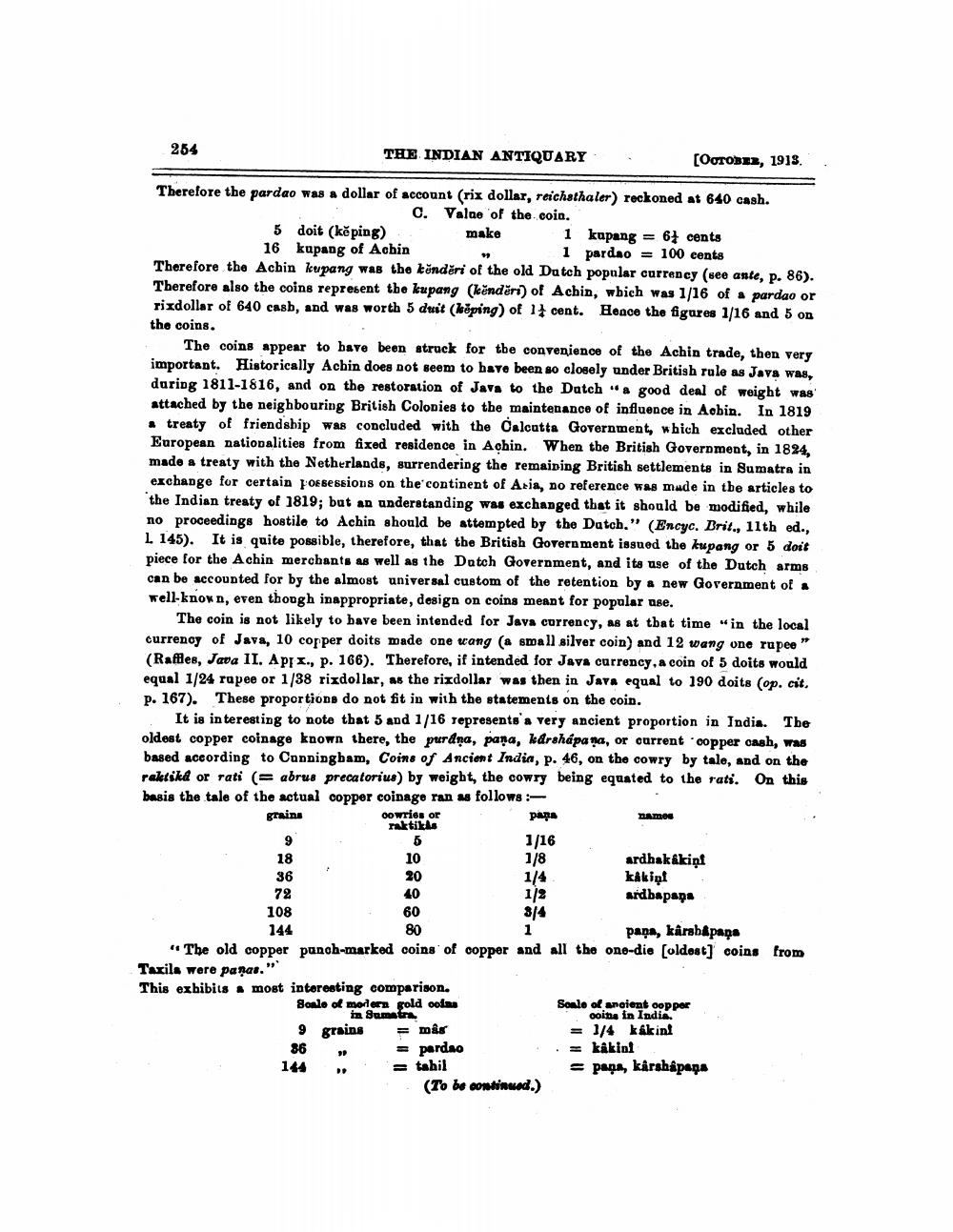________________
254
THE INDIAN ANTIQUARY
[Остовив, 1913.
Therefore the pardao was a dollar of account (rix dollar, reichsthaler) reckoned at 640 cash.
C. Value of the coin. make
5
1 kupang= 64 cents 1 pardao = 100 cents
doit (keping) 16 kupang of Achin Therefore the Achin kupang was the kĕndĕri of the old Dutch popular currency (see ante, p. 86). Therefore also the coins represent the kupang (kenderi) of Achin, which was 1/16 of a pardao or rixdollar of 640 cash, and was worth 5 duit (keping) of 1 cent. Hence the figures 1/16 and 5 on the coins.
The coins appear to have been struck for the convenience of the Achin trade, then very important. Historically Achin does not seem to have been so closely under British rule as Java was, during 1811-1816, and on the restoration of Java to the Dutch "a good deal of weight was attached by the neighbouring British Colonies to the maintenance of influence in Achin. In 1819 a treaty of friendship was concluded with the Calcutta Government, which excluded other European nationalities from fixed residence in Achin. When the British Government, in 1824, made a treaty with the Netherlands, surrendering the remaining British settlements in Sumatra in exchange for certain possessions on the continent of Asia, no reference was made in the articles to the Indian treaty of 1819; but an understanding was exchanged that it should be modified, while no proceedings hostile to Achin should be attempted by the Dutch." (Encyc. Brit., 11th ed., L 145). It is quite possible, therefore, that the British Government issued the kupang or 5 doit piece for the Achin merchants as well as the Dutch Government, and its use of the Dutch arms can be accounted for by the almost universal custom of the retention by a new Government of a well-known, even though inappropriate, design on coins meant for popular use.
The coin is not likely to have been intended for Java currency, as at that time "in the local currency of Java, 10 copper doits made one wang (a small silver coin) and 12 wang one rupee (Raffles, Java II. Appx., p. 166). Therefore, if intended for Java currency, a coin of 5 doits would equal 1/24 rupee or 1/38 rixdollar, as the rixdollar was then in Java equal to 190 doits (op. cit. p. 167).
These proportions do not fit in with the statements on the coin.
It is interesting to note that 5 and 1/16 represents a very ancient proportion in India. The oldest copper coinage known there, the purdna, pana, kárshápana, or current copper cash, was based according to Cunningham, Coins of Ancient India, p. 46, on the cowry by tale, and on the raktika or rati (= abrus precatorius) by weight, the cowry being equated to the rati. On this basis the tale of the actual copper coinage ran as follows:
pana
oowries or raktikas
grains 9 18
5
10
T
36
20
1/16 1/8 1/4 1/2 3/4 1
40
60 80
paņa, karahapana
"The old copper punch-marked coins of copper and all the one-die [oldest] coins from Taxila were panas." This exhibits a most
72
108 144
interesting comparison. Scale of modern gold coins in Sumatra.
86
9 grains = mås = pardao = tahil
144
39
(To be continued.)
names
ardhakakini kakipl andhapapa
Scale of ancient oopper coins in India.
= 1/4 kakin!
= kâkin!
papa, kârshapana




